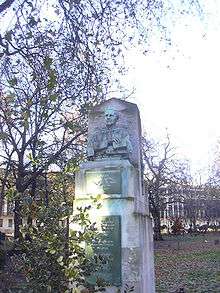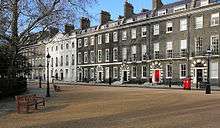Tavistock Square

Tavistock Square is a public square in Bloomsbury, in the London Borough of Camden.
History
Tavistock Square was built in the 1820s by the the property developer James Burton and the master builder Thomas Cubitt for Francis Russell, 5th Duke of Bedford, and formed part of the Bedford Estate in London, owned by the Dukes of Bedford. The square is now owned and administered by the London Borough of Camden. The square takes its name from Francis Russell, Marquess of Tavistock, whose title dates to 1694 when his ancestor was Lord Lieutenant of Tavistock, a market town in Devon, also part of a Bedford estate. Marquess of Tavistock is a courtesy title given to the eldest sons of the Dukes of Bedford.
In 1920 the Tavistock Clinic was founded in the square, a pioneering psychiatric clinic whose patients included shell-shock victims of the First World War. In 1946 the Tavistock Institute of Human Relations separated from the Tavistock Clinic. The Tavistock Clinic has since moved to Hampstead and the Tavistock Institute to Islington.
2005 London bombings
Tavistock Square was the scene of one of the four suicide bombings on 7 July 2005. The bomb was detonated by 18-year-old Hasib Hussain on a double-decker bus bearing route number 30; it had been diverted from its normal route along Euston Road because of traffic disruption by the other three bombings at tube stations. The bomb exploded immediately outside the British Medical Association building, many of whose staff came out to give what help they could. The explosion killed 13 passengers, plus Hussain himself. Many others were injured.
On the occasion of the first anniversary in 2006, the Department for Culture, Media and Sport announced that the square would be the site of the permanent national memorial. A memorial garden is to be laid out in part of the existing garden and the BMA has commissioned a commemorative sundial.
Public art
The centre-piece of the gardens is a statue of Mahatma Gandhi, sculpted by Fredda Brilliant and installed in 1968. The hollow pedestal was intended, and is used, for people to leave floral tributes to the peace campaigner and nonviolent resister to oppression in South Africa and British rule in India.[1]
A cherry tree was planted in 1967 in memory of the victims of the atomic bombings of Hiroshima and Nagasaki.
A generation later, in 1994, the Conscientious Objectors Commemorative Stone commemorating "men and women conscientious objectors all over the world and in every age" by Hugh Court[2] was unveiled.
These three features have led to the square unofficially being regarded by some as a peace park or garden, and annual ceremonies are held at each of these memorials.
A bust of the writer Virginia Woolf, cast from a 1931 sculpture by Stephen Tomlin (1901–1937), was unveiled in 2004 at the south-west corner of the square. Woolf lived at 52 Tavistock Square between 1924 and 1939. From there she and her husband Leonard Woolf ran The Hogarth Press, which became a prominent and influential publisher at the forefront of modernist fiction and poetry (publishing T.S. Eliot, E.M. Forster and Katherine Mansfield among others) and translating the works of Sigmund Freud into English. Their house was destroyed by a bomb in October 1941 during the London blitz. The south side of the square where Woolf lived is now occupied by a hotel.
The square also contains a bust of the surgeon Dame Louisa Aldrich-Blake.

Buildings
The following buildings are on Tavistock Square:
- Tavistock House, home of James Burton while he developed the area and then of Charles Dickens. A blue plaque on BMA House commemorates him. Subsequently it was demolished in 1901 and replaced by:
- "BMA House", designed by Sir Edwin Lutyens in 1911[3] and is a grade II listed building.[4] It is the headquarters of the British Medical Association (BMA), the professional association of doctors in the United Kingdom.
- The headquarters of the Medical Schools Council, an organisation which represents the interests and ambitions of UK medical schools as they relate to the generation of national health, wealth and knowledge through biomedical research and the profession of medicine.
- Woburn house, the headquarters of Universities UK, the conference of university rectors
- the Tavistock Hotel, a branch of Imperial Hotels.[5]
- Connaught Hall, a University of London hall of residence, which houses 215 students, and is a grade II listed building.
- Institute for the Study of the Americas, part of the University of London's School of Advanced Study
- School of Public Policy of University College London.
- London office of Churches Together in England
- Commonwealth Scholarship and Fellowship Plan, United Kingdom office
- Development Planning Unit, University College of London
Gallery
-

Statue of Mahatma Gandhi from the East.
-

Plaque at the base of the Hiroshima cherry tree amid fallen blossoms.
-

Conscientious Objectors Commemorative Stone, on the north side of the Square.
-

Conscientious Objectors Stone inscription
-

Memorial to Louisa Aldrich-Blake
-

Blue plaque on the BMA building commemorating Dickens and Tavistock House
See also
Other squares on the Bedford Estate in Bloomsbury included:
Nearby Endsleigh Gardens, Endsleigh Street and Taviton Street take their names from the Bedford estate in Devon, south-west England.
References
- ↑ "Cheltenham Town Hall 2". Antiques Roadshow. Series 35. Episode 19. 2013-04-14. BBC Television. Retrieved 2013-04-16.
- ↑ http://www.ppu.org.uk/memorials/peace/london/costone.html
- ↑ "About BMA House". BMA House. Retrieved 12 July 2016.
- ↑ "Where to Find Us". BMA House. Retrieved June 27, 2015.
- ↑ "Tavistock Hotel". Travel Weekly. Retrieved June 27, 2015.
External links
Coordinates: 51°31′30″N 0°07′45″W / 51.5250°N 0.1291°W List of eponymous roads in London
